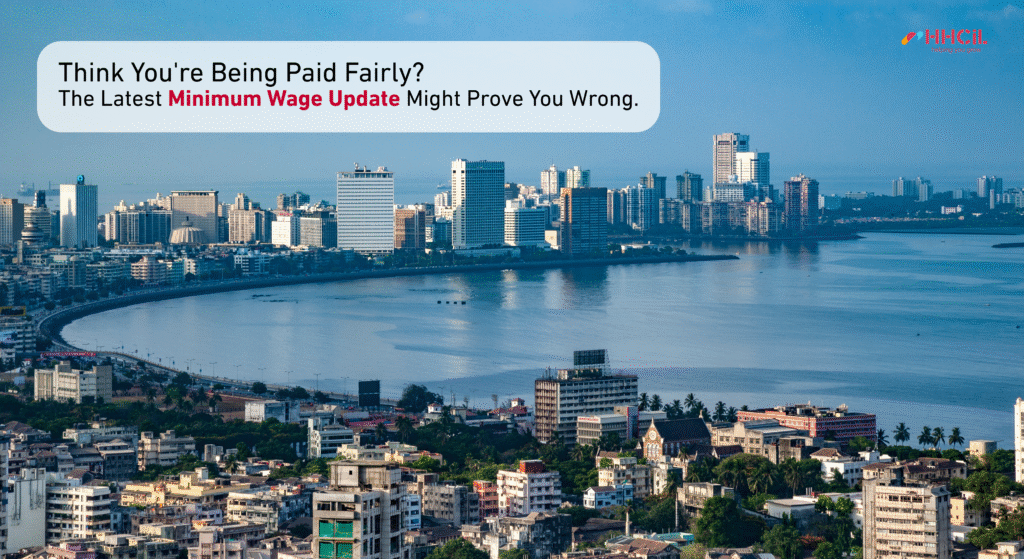If you are working in Maharashtra or managing a business with employees, there’s an important update you need to know. Starting from 1st July 2025, the Maharashtra government has announced revised minimum wages for various industries and job roles. These rates will be in effect till 31st December 2025.
This isn’t just a technical update in government records. These wages directly impact your salary (if you’re an employee) and define your legal obligations (if you’re an employer). So, whether you are a fresher joining your first job or a business owner ensuring compliance, this update affects you.
Let’s break it down in a way that’s simple, clear, and directly useful.
What is the Maharashtra Minimum Wages Act?
The Minimum Wages Act, 1948 was created to protect workers. It ensures that no employee is paid less than the basic cost of living for the work they perform.
In Maharashtra, the government periodically revises these wages considering:
- The type of industry
- The worker’s skill level (Skilled, Semi-Skilled, Unskilled)
- The city or region (Metro cities, small towns, rural areas)
- Adjustments for inflation and rising living costs
The updated rates are mandatory for all businesses that fall under the list of scheduled employment.
How are Maharashtra Minimum Wages Structured?
Minimum wages are not just a single figure. They are divided into two parts:
- Basic Wage (मूल वेतन दर): This is the fixed part of your salary, based on your job role.
- Special Allowance (विशेष भत्ता): This is an additional amount to help manage rising living costs (adjusted every six months).
When combined, these two amounts form your Total Minimum Wage (एकूण किमान वेतन).
Zone-wise Wage Categories in Maharashtra
Not every region in Maharashtra has the same cost of living. So, the government has divided the state into three wage zones:
- Zone 1: Major metro cities and industrial hubs like Mumbai, Pune, Nagpur.
- Zone 2: Municipal councils and mid-sized towns.
- Zone 3: Semi-urban and rural areas.
This means a worker performing the same job in Mumbai (Zone 1) will legally earn more than someone in a smaller town (Zone 2) or a rural area (Zone 3). This zoning ensures fairness, considering differences in expenses across regions.
Skilled, Semi-Skilled, and Unskilled – What’s the Difference?
Your minimum wage also depends on how your job is classified:
- Skilled Worker (कुशल): Jobs that require specific training, experience, or certification.
- Semi-Skilled Worker (अर्धकुशल): Jobs that need some level of training but not expert-level skills.
- Unskilled Worker (अकुशल): Jobs that do not require formal training or specialized skills.
Each of these categories has different wage rates under the Maharashtra Minimum Wages notification.
For example:
- A Skilled worker in a chemical factory in Mumbai will earn a higher salary compared to a Semi-Skilled or Unskilled worker in the same factory.
- Similarly, a Skilled worker in a rural area will still earn less than a Skilled worker in a metro city due to the difference in zones.
Industries Covered in the Maharashtra Minimum Wages Notification
This notification applies to a wide range of industries and businesses, including:
- Manufacturing units (engineering, textiles, printing)
- Chemical and fertilizer factories
- Hospitality (hotels, restaurants, catering)
- Healthcare (hospitals, clinics)
- Shops and commercial establishments
- Transportation and logistics
- Beedi and tobacco industries
- Security services and facility management companies
If your business or job role falls under these industries, these wages are mandatory and not optional.
Why Should Workers Care About This?
If you are an employee, this wage structure defines:
- The salary you must receive as per the law.
- The breakdown of your salary components (basic wage + allowance).
- Protection against underpayment, even if you’re on a contract or third-party payroll.
If you notice that your salary is below these notified rates, you can raise a complaint with the Labour Commissioner’s Office. This Act is designed to safeguard workers, especially those in entry-level or blue-collar jobs, from being underpaid.
Why Employers Must Take This Seriously
For employers, this isn’t just a guideline it’s a legal requirement. Non-compliance can result in:
- Heavy fines and penalties
- Legal action and potential court cases
- Inspections and audits by labor authorities
- Damage to business reputation and worker trust
Employers must ensure that:
- Payroll systems are updated as per the new rates.
- Wage registers and compliance records are maintained.
- Both direct employees and third-party workforce are paid in line with the notification.
Common Mistakes to Avoid
- Ignoring zone-wise wage differences and applying a single rate for all locations.
- Not including the Special Allowance in the salary calculation.
- Assuming that off-roll or contract workers are exempted (they are not).
- Outdated payroll structures not reflecting the latest wage revisions.
What Happens if You Don’t Comply?
For Employees:
- You can file a grievance with labor authorities if paid below the minimum wage.
- You are entitled to back-pay and compensation for underpaid periods.
For Employers:
- Penalties can range from fines to business restrictions.
- Continuous non-compliance can lead to serious legal troubles and labor disputes.
Conclusion: Be Aware. Stay Compliant.
The Maharashtra Minimum Wages (July-December 2025) notification is more than a set of numbers. It is a legal and ethical benchmark that ensures fair wages for workers and legal compliance for businesses.
As an employee, it empowers you with the right to fair pay. As an employer, it protects your business from compliance risks and helps maintain a healthy work environment.
If you are unsure about the wage rates applicable to you or your business, it is recommended to consult a labor law expert or reach out to the Labour Department for clarity.
Maharashtra Minimum Wages are not optional. They are your right. Know them, demand them, and respect them.






